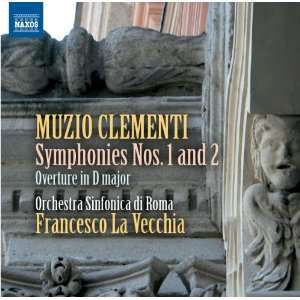|
Back
01/31/2013
Muzio Clementi: Overture in D major – Symphony N° 1 in C major, WO 32 – Symphony N° 2 in D major, WO 33
Orchestra Sinfonica di Roma, Francesco La Vecchia (Conductor)
Recording: OSR Studios, Rome, Italy (December 29-30, 2011) – 60’10
Naxos #8.573071 – Translation in English and Italian

   
Muzio Clementi is synonymous with creating extensive exercises for piano. His virtuosities, however, didn’t end there, having been an active teacher, publisher and even piano manufacturer. Even though this “Renaissance Man” was overshadowed by the likes of Haydn, Mozart and Beethoven, his objective was to make a debut in the big arena by scoring a collection of six significant symphonies. Clementi, however, was lying on the fringes of discovery in this genre just as the transition of the formulaic symphonic format was coming to a close. Timing is everything and Muzio Clementi got caught in the metamorphic crosshairs, so he was swept under the rug. It wasn’t until Georges du Parc Poulain Saint-Foix garnered Clementi’s loose manuscripts only to be carried one step forward by Alfredo Casella in 1935 who, through the channels of the Library of Congress, was able to reformulate the two symphonies which are featured on this recording. The Orchestra Sinfonica di Roma, led by Francesco La Vecchia, paints Clementi’s works with respectful candidness and transparency.
This Naxos recording is an intermission from expectant composers of the early 19th century. Think larger than piano and technique...think symphonic intensity and immeasurable continuity. Clementi mastered all of this on a level that’s never been fully recognized for years.
Melodic formulation has its advantages. The cohesive two sectioned structure in the Overture in D major and beginning movements of the subsequent symphonies follow the same course: opening passages focus on thematic qualities with a more upright, attentive grade that soon continues with a more relaxed, brisk and frivolous pacing. The aforementioned accentuation has spirited, vivacious passion. Tinges of Beethoven are discerning, yet Clementi pens his notes that separate himself into a sense of self fulfillment.
Clementi pays particular attention to aligning himself with the traditional four movement framework, indicative of his time. Both symphonies pattern themselves with a “Minuetto” and a conclusive presto paced conclusion. Particularly, Clementi’s Symphony No° 2 in D major opens with a beautiful dichotomous “Adagio-Allegro” which has bearings of an impish, light-hearted Mozart. Woodwinds, specifically flutes, play an important role in the Clementi compositions. These filigree touches add grace, finesse, sophistication and completion.
Muzio Clementi deserves greater commendation in light of the pivotal contributions he brought to the Classical Era. La Vecchia has a treasure on its hands.
Christie Grimstad
|